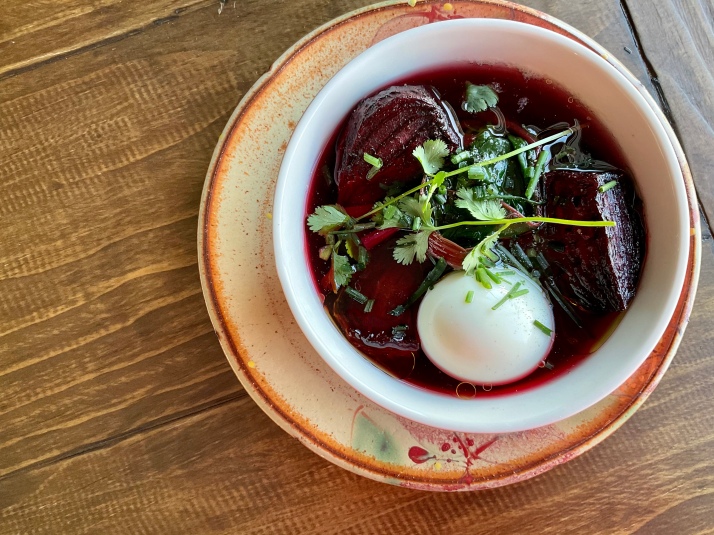
Dishes like these have been my saviour this winter. More importantly, “fresh” winter produce, which surprisingly, given the current climate, has been abundant, has been my inspiration. We have been happily feasting on escarole, arugula, and spinach, mounds of them! So when I came across the bunches of beet roots, red stems still very much in tact and sturdy green leaves, though small, untouched, I had no choice, but to snatch them up. These were not winter grade. You have heard that rant before, and so brought me back to my summer market days…
You know that leafy greens are the only vegetables I boil, and of which I can literally eat heaps. This dish takes that plate of boiled leafy greens to a whole other level. For starters, it incorporates at its center beet root greens, which are often discarded, shameful in my opinion. When cooked, they surrender beautifully reminiscent of Swiss chard. They render the broth a bright ruby red that’s been infused with a hint of garlic and ginger and finished with a squeeze of lemon juice and drizzle of olive oil for body. Roasted beets, really, candied vegetables, are then added, and only because I hate boiled vegetables and because roasting brings out the best in everything, particularly veggies. Topped with a hard boiled egg, it’s a complete meal, hardy bowl, and just a beautiful way to eat more beets!
Every time I make a beet dish, beets at the center or not, I’m reminded how much I really do like beets, but also how much I can’t be bothered to incorporate them more often because let’s face it, they’re a little bit messy. This dish is full bodied, robust, and a celebration of all things beets (beets three ways!) for which its worth getting your hands dirty!
Serves 3
Ingredients:
| Roasting Beets: | |
| Beets, quartered | 5-6 |
| Olive oil | |
| Salt | |
| Black pepper | |
| Boiling Greens: | |
| Water | 4 Litres (16 cups) |
| Greens, beets, bunches | 1.5 lbs |
| Garlic, cloves, large, crushed | 3 |
| Ginger, sliced | 2 1-inch Pieces |
| Salt | 2 tbsp |
| Per Bowl: | |
| Olive oil | 1 tbsp |
| Juice, lemon | 1 tsp |
| Broth, Beet, 3 cups total | 1 cup / bowl |
| Eggs, soft-boiled | 3 |
| Chives | |
| Cilantro / dill / marjoram, fresh, chopped | Garnish |
| Black pepper | Garnish |
Directions:
Roasting Beets
- Preheat oven to 375F.
- Toss quartered beets with olive, salt and black pepper.
- Bake for 45-60 minutes until cooked and caramelized.
Cooking Beet Greens
- Bring a medium pot filled three quarters of the way up with water (4 litres) to a boil.
- Generously salt the pot (2 tbsp of salt) and add crushed garlic and ginger.
- Simmer for 5 minutes so that water infuses with garlic and ginger.
- Add beet greens and cook for approximately 7 minutes until tender.
- Remove pot from stove.
Assembly
- Add 1 tsp lemon juice (or to taste) and 1 tbsp of olive oil to each bowl and stir.
- Using a slotted spatula, divide the beet greens into 3 bowls reserving the beet broth.
- Fill each bowl with 1 cup of beet broth.
- Place 4-5 roasted beets into each bowl.
- Add whole hard-boiled egg to bowl.
- Sprinkle each bowl with chives, fresh herbs, and black pepper.

